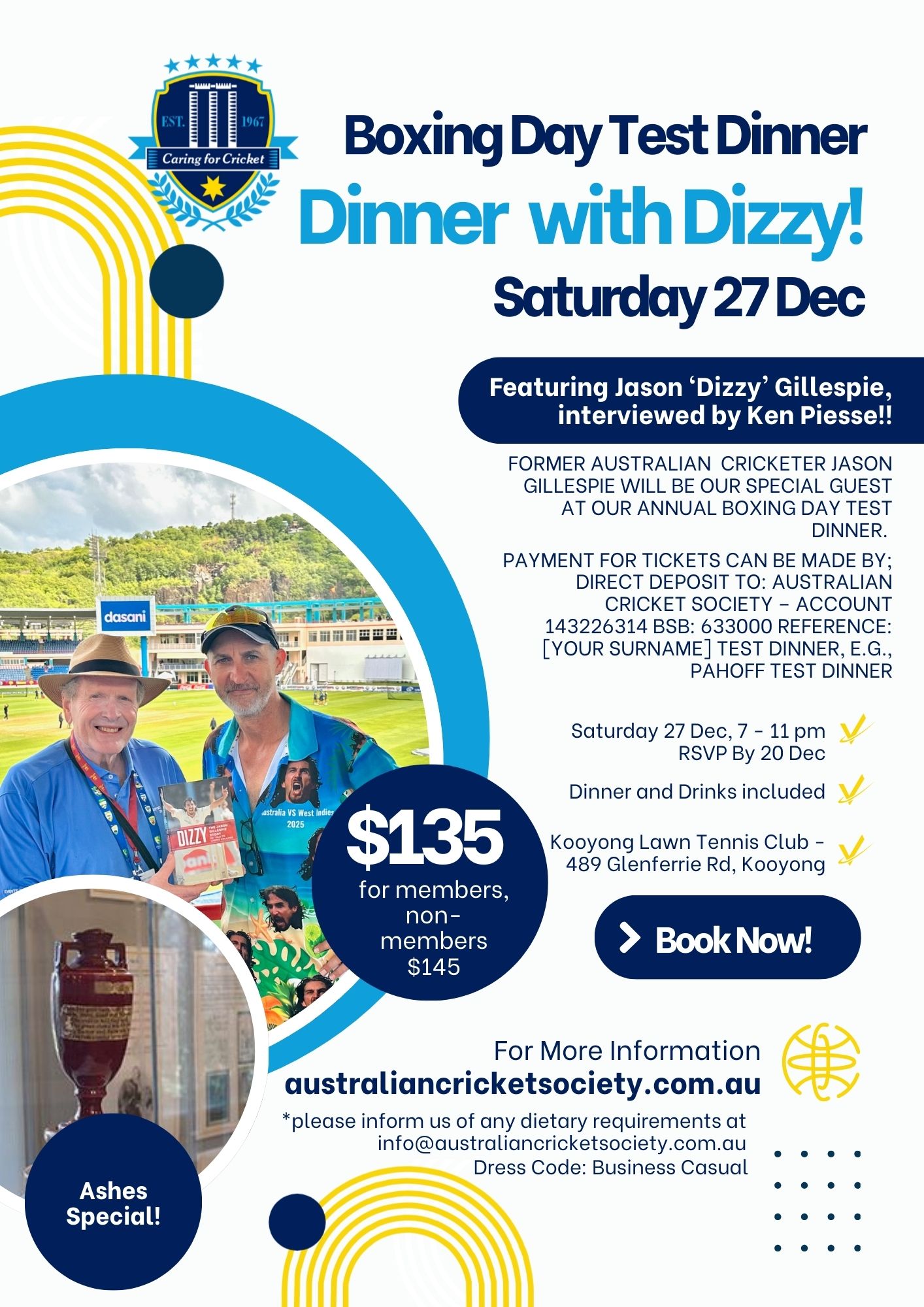By Liam McCullagh, incoming ACS Journalism Scholar (mentored by The Footy Almanac‘s John Harms).
There aren’t too many names in Sri Lankan cricket more highly regarded than the mini-maestro Aravinda de Silva. Standing 5 foot 3, the flamboyant batting all-rounder is regarded by many as one of the most influential cricketers in Sri Lanka’s history.
He was known for his stroke play square of the wicket, particularly to short-pitched bowling, with his signature shot being the pull or hook. Aravinda de Silva was equally strong through the leg side, whipping many-a-player off his pads in his career.
What stood out when Aravinda de Silva spoke to the Australian Cricket Society at a recent dinner was his involvement and fondness of Victorian Premier cricket. He played for Prahran in 1988/89. He spoke glowingly of his time spent in Melbourne, with his cricketing exploits extending down the highway, near my hometown of Colac.
When, on the day after the dinner, I travelled back to Colac for a mate’s 21st, I told our Division 3 Cricket Captain Darren Hay that I attended the event, and he said he actually had the pleasure of batting with him.
There used to be a competition called the XXXX Cup where Colac played against Warrnambool. The games featured three or four state players on each of the teams, and served as a test against the best for those that had never played district cricket in Melbourne. Tony Dodemaide and Jamie Siddons were other notable state cricketers Darren remembered being part of it all.
In Darren’s first year playing in the match (1987/88) he missed out on facing Merv Hughes after being struck by a bouncer. The next year he was picked and after batting as an opener for Warrion, he settled for Number 3, as de Silva opened. Coming in with the score at 1/70 odd, with de Silva in full flight, Darren wanted to take his time to build an innings. He started at the non-striker’s end. First ball, de Silva hit for four off his pads, the next was only just reeled in by the fielding team for 3. Darren was on strike, with a Sri Lankan professional at the other end, and he blocked the first ball. Darren left the second and defended the third ball. Then the large crowd which had congregated in Warrnambool started booing. They wanted de Silva back on strike. It sums up Aravinda de Silva, a cricketer who captivated crowds no matter where he played.
De Silva played 93 Test matches (seventh most), and 308 ODI’s (seventh most) and is sixth in Test match runs for Sri Lanka with 6361 at an average of 42 and sits fifth in ODI runs for Sri Lanka with 9284 at an average of 34. De Silva also captained his country in 6 Tests and 18 ODI matches. De Silva made 31 international 100s with a high score of 267 which was in 1991 against New Zealand at Basin Reserve. In fact, many of de Silva’s iconic innings were away from home sub-continent conditions, he scored 167 in a 1989 drawn match at Australia’s fortress, the Gabba.
Another thing which surprised me when he spoke about his time at Prahran was the number of double hundreds he made. When de Silva was set, he seemed impossible to dismiss.
There were jabs about him running up the phone bill calling his parents back in Sri Lanka, sleeping in and slacking at work but as Ian Crawford came onto stage (Ian was involved in landing de Silva at Prahran), Aravinda’s admiration for cricket in Melbourne and Victoria was apparent. They reminisced about his lightning speed between the wickets, his tenacious endeavour to score runs, and his love for his family.
Making his debut at Lord’s Cricket Ground in 1984 against a David Gower led English side, de Silva was dismissed for 16 and 3, but it wasn’t a sign of things to come. Playing in an era full of world class bowlers, de Silva picked Wasim Akram as his most difficult to face, de Silva said what made him special was his ability to swing the ball both ways, and move it late.
One thing which also stood out on the night was how hard de Silva said Sri Lanka worked in preparation for the 1996 World Cup. De Silva mentioned the Sri Lankan team would wake at 6am to run 16 laps of the oval and train all day.
At the function he was so generous with his time, signing bats, taking photos, all with a smile.
Australian cricket fans would remember de Silva most for his 1996 World Cup finals campaign which saw him Man of The Match in the semi-final against India scoring 66 off 47 (his first 50 came off 32 balls) and taking 1 for 3 off 2 overs.
Winning the toss in the Final, Sri Lanka elected to bowl first, Australia was cruising at 1/137, Mark Taylor and Ricky Ponting at the crease. De Silva broke the key partnership, getting Taylor out sweeping to deep square, and not too long later ripped one through Ponting, and later bowled Ian Healy, turning one through the gate. He finished with figures of 3/42 off 9 overs, as well as two crucial catches in Steve Waugh and Stuart Law.
De Silva then came to the crease with Sri Lanka in a bit of strife at 2 for 21 chasing Australia’s total of 241. Through a partnership of 125 runs with Asanka Gurusinha (who scored 65 off 99), de Silva guided Sri Lanka to victory with an unbeaten 107 off 124. De Silva hit 13 boundaries in the World Cup final.
De Silva retired from international cricket after the 2003 ODI World Cup, with his final match being a semi-final against Australia.
Kumar Sangakkara lists de Silva as one of his top six favourite batsmen ever and regards de Silva has one of the greatest influences on his career.
In 2019 Sangakkara wrote an article for Wisden Cricket and said, “Not just me, but a whole generation of cricketers will forever be grateful that we watched him play. He can rest assured that he’s without doubt one of the greatest Sri Lankan batsmen to ever play the game.”
De Silva was a driving force in Sri Lanka’s golden generation of cricket, he played with vigour and grace which left opposing fans envious, inspired the next wave of Sri Lankan superstars and was ice cool under pressure.
Australian Cricket Society’s literary scholar Liam McCullagh is mentored by writer John Harms. His pieces are also published at www.footyalmanac.com.au .

